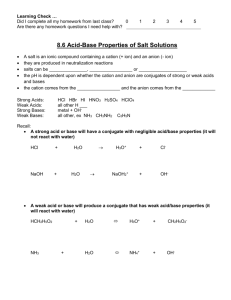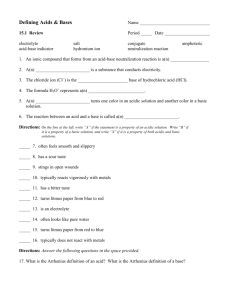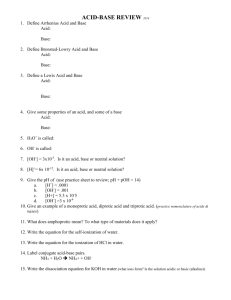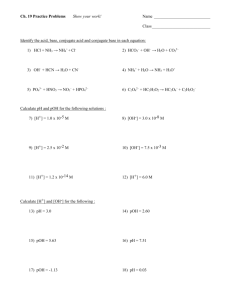Relationship Between Ka and Kb
advertisement
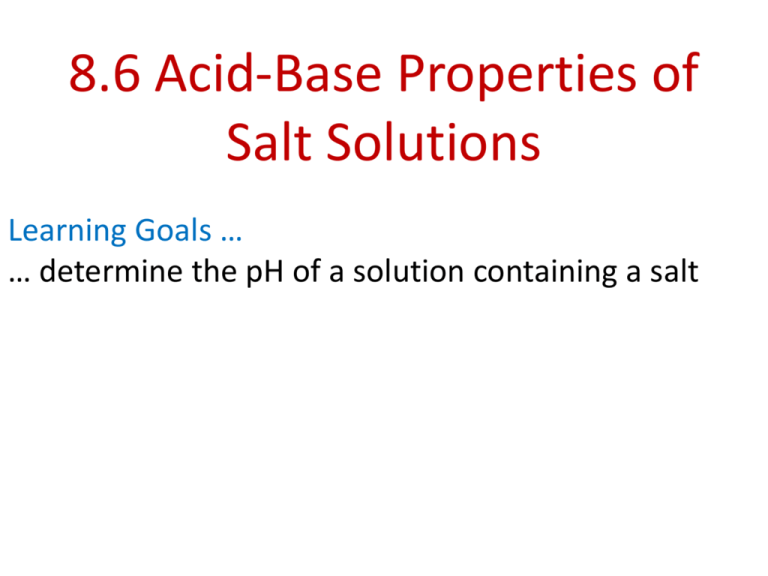
8.6 Acid-Base Properties of Salt Solutions Learning Goals … … determine the pH of a solution containing a salt • A salt is an ionic compound containing a cation (+ ion) and an anion (- ion) • they are produced in neutralization reactions • salts can be acidic, basic or neutral • the pH is dependent upon whether the cation and anion are conjugates of strong or weak acids and bases • the cation comes from the base and the anion comes from the acid Strong Acids: Weak Acids: Strong Bases: Weak Bases: HCl HBr HI HNO3 H2SO4 HClO4 all other H ___ metal + OHall other, ex NH3 CH3NH2 C5H5N Recall: A strong acid or base will have a conjugate with negligible acid/base properties (it will not react with water) HCl + H2O strong acid NaOH strong base H3O+ + Clnegligible conj base Cl- + H2O NR Na+ negligible conj acid Na+ + H2O NR + OH- A weak acid or base will produce conjugate that has weak acid/base properties (it will react with water) HCH2H5O2 weak acid + H2O H3O+ + CH2H5O2weak conj base CH2H5O2- + H2O HCH2H5O2 + OHpH > 7 NH3 + H2O weak base NH4+ + OHweak conj acid NH4+ + H2O NH3 + H3O+ pH < 7 Salts that Produce Neutral Solutions… Ex: NaCl, Ca(NO3)2, KBr • Cation (eg Na+) is the conjugate of a strong base (eg NaOH) and therefore has negligible acidic properties. • Anion (eg Cl-) is the conjugate of a strong acid (eg HCl) and therefore has negligible basic properties. • Neither of the ions act as an acid or a base and thus the pH is neutral • a salt produced in the reaction of a STRONG ACID and STRONG BASE will be NEUTRAL Salts that Produce Acidic Solutions… Ex: NH4Cl • Cation (NH4+) is the weak conjugate acid of a weak base (NH3). This conjugate acid would thus react with water to produce H3O+. NH4+ + H2O NH3 + H3O+ • Anion (Cl-) is the conjugate of a strong acid (eg HCl) and therefore would have negligible basic properties. • Cation acts as an acid; anion has no effect on pH • a salt produced in the reaction of a STRONG ACID and WEAK BASE will be ACIDIC Ex) What is the pH of a 0.35 M NH4Cl solution? (Kb for ammonia is 1.8x10-5) NH4Cl(aq) 0.35 M NH4+(aq) 0.35 M NH4+ + H2O i c e 0.35 M -x 0.35 - x NH3 0 +x x + + Cl-(aq) H3O+ 0 +x x Ka = Kw = 1x10-14 = 5.56x10-10 Kb 1.8x10-5 Ka value needed for NH4+ Ka = (x)(x) (0.35 – x) = 5.56x10-10 Can we simplify? 0.35/Ka > 100 YES x2 (0.35) = 5.56x10-10 x2 = 1.946x10-10 x = 1.39x10-5 [H3O+] = x = 1.39x10-5 pH = -log(1.39x10-5) pH = 4.86 Salts that Produce Basic Solutions… Ex: NaCH3COO • Anion (CH3COO-) is the weak conjugate base of a weak acid (CH3COOH). This conjugate base would thus react with water to produce OH-. CH3COO- + H2O CH3COOH + OH- • Cation (Na+) is the conjugate of a strong base (eg NaOH) and therefore will have negligible acidic properties. • Anion acts as a base; cation has no effect on pH • a salt produced in the reaction of a WEAK ACID and STRONG BASE will be BASIC Ex) Calculate the pH of a solution that contains 12.5g of sodium acetate (NaCH3COO) dissolved in 1.0L of H2O. (Ka for acetic acid is 1.8x10-5) NaCH3COO(aq) Na+(aq) + CH3COO-(aq) n m M C V 0.152 mol 12.5 g 82.04 g/mol 0.152 M 1.0L CH3COO- i c e 0.152 M -x 0.152 - x + H2O Kb value needed 0.152 M CH3COOH 0 +x x + OH-(aq) 0 +x x Kb = Kw = 1x10-14 = 5.56x10-10 Ka 1.8x10-5 Kb = Can we simplify? > 100 YES (x)(x) = 5.56x10-10 (0.152 - x) x2 = 5.56x10-10 (0.152) x2 = 8.45x10-11 x = 9.2x10-6 [OH-] = x = 9.2x10-6 pOH = -log(9.2x10-6) pOH = 5.04 pH = 14 - pOH pH = 8.96 What about if the salt contained an ion that is AMPHOTERIC? Ex) Is the solution of KH2PO4 acidic or basic? The anion H2PO4- can act as both a weak acid and a weak base Ka2 = 6.3x10-8 H2PO4- + H2O HPO42- + H3O+ H2PO4- + H2O H3PO4 + OH- Kb = Kw/Ka1 =1.4x10-12 Since the Ka > Kb, H2PO4- will act as an acid and the solution will be acidic. Salt Solutions Sort the following salts based on whether they form acidic, neutral, or basic solutions when dissolved in water. NaCl C5H5NHCl NH4NO3 LiF NH4NO3 C5H5NHCl NaClO KCN NaClO NaCl LiF KCN Self Check How prepared am I to start my homework? Can I … … determine the pH of a solution containing a salt HOMEWORK p534 #1, 2 p536 #1,2 p539 #1,4


